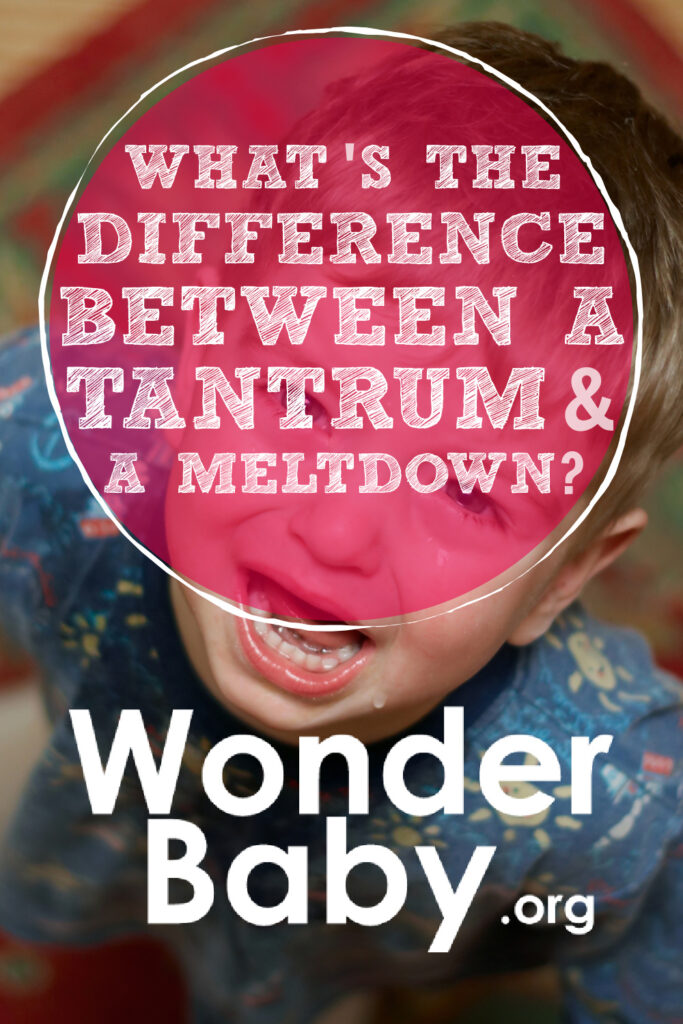What’s the Difference Between a Tantrum and a Meltdown?

- While tantrums and meltdowns are similar, they do have some key differences.
- Learning these differences can help parents react appropriately.
- At times, a tantrum may lead to a sensory meltdown.
- Staying calm and modeling self-regulation are helpful tools in dealing with both tantrums and meltdowns.
My 7-year-old son stood in our garage, frantically screaming at me. His clothes had gotten wet from the water hose, and he wanted to go inside to take them off. I told him he couldn’t walk inside with sopping wet shoes and socks.
That’s when the screaming and crying began.
To an outsider, it would appear he was throwing a temper tantrum. But as I sat and observed my neurodivergent son, I could see in his eyes he was struggling, and no amount of talking to him would help.
He wasn’t having a tantrum because I told him “no.” He was having a meltdown, brought on by sensory overload.
The wet clothes, grass clippings, and excitement were fun while they lasted, but he reached his breaking point and was desperate for less stimuli and the familiarity of warm, dry socks.
Instead of disciplining him, I decided to help him figure out what he needed to feel regulated. He was able to tell me he needed a towel and new clothes. We worked together to get his wet socks off quickly because his feet are susceptible to overload.
He calmed down once his wet clothes were off and he was wrapped warmly in a towel.
Rarely is the difference between tantrums and meltdowns ever discussed. Often, the two are used as synonyms of each other and seen as defiance or obstinance.
As more research is done on the developing brain and the nuances that make each kid unique, we’ve learned that not all outbursts and intense emotional expressions are due to rebellion. Many times, the experience isn’t within the person’s control.
Are Temper Tantrums and Meltdowns the Same?

People of all ages experience both tantrums and meltdowns. They occur in both neurotypical and autistic people alike. Although common, they’re misunderstood chiefly because they appear very similar. However, they are not the same; their differences are significant.
Autistic meltdowns can look like your child throwing herself on the floor, screaming, hitting a sibling, or completely shutting down and refusing to respond to prompts or questions. Yet, so can a tantrum.
Sometimes, they get very loud or can also be completely silent and witnessed only by an act of defiance. Also, so can a tantrum.
Temper tantrums and meltdowns are not the same thing. They do, however, have some similarities. Both are:
- An emotional explosion
- Sudden
- Disruptive
- Common in younger children, but possible for all ages
- A form of communication
What Makes Temper Tantrums and Meltdowns Different?

Meltdowns and the classic temper tantrum have essential differences.
Meltdowns happen when the child has experienced too much stimulation and becomes overwhelmed. On the other hand, tantrums often begin with a behavioral act—such as a parent setting a boundary or transitioning from one activity to another.
Typical tantrums are an emotional response of obstinance or resistance to the boundary, resulting in the child’s behavior becoming reactive. Often, they are trying to get their way, reacting to a schedule change or testing limits. Children can calm tantrums through self-regulation11. How Can We Help Kids With Self-Regulation?. Child Mind Institute. 2023. https://childmind.org/article/can-help-kids-self-regulation or with distractions.
On the other hand, sensory meltdowns are due to a child’s body reacting to too many stimuli.
An autistic child is most vulnerable to a sensory meltdown due to their high sensitivity to the sensory stimuli they experience. When the brain cannot process any more stimuli, it will go into “panic mode.” Panic mode will produce explosive reactions—screaming, fighting, kicking, self-harm, and destroying items are standard.
For example, a festival or concert can be very stimulating with all the lights, sounds, smells, and people. At first, it can be enjoyable and embraced, but too much exposure or an unexpected change can overwhelm her.
When sensory input is overloaded, a meltdown is inevitable.
How to Tell the Difference Between a Tantrum and a Meltdown

At first, differentiating between a tantrum and a meltdown can be challenging. They both can come on suddenly and with intensity. They both can be hard to understand. You may be left breathless and overwhelmed.
Learning about what causes will help you stay calm and handle the situation appropriately.
Not long ago, all explosive emotional expressions were punished or reprimanded. In the last few decades, much research has been done on autism and the autistic meltdown. Thanks to this research, we better understand what triggers meltdowns, not only in those with autism spectrum disorder but all people.
According to the Autism Treatment Center of America22. The Difference Between Meltdowns and Tantrums. Autism Treatment Center of America. 2021. https://autismtreatmentcenter.org/knowledge-base/the-difference-between-meltdowns-and-tantrums, “The main difference between tantrums and meltdowns is that tantrums have a purpose, and meltdowns are the result of sensory overload.”
If your child starts screaming and crying because you told him he couldn’t have more ice cream, but the crying stops when you promise him more ice cream tomorrow, you’re likely dealing with a tantrum.
You’re dealing with a meltdown if he starts rocking, crying, hitting, screaming, or being destructive after a trip to the park and grocery store, and no coercing or distractions help him.
What Triggers Temper Tantrums and Meltdowns in Children?

After a meltdown or tantrum, many parents begin wondering what can be done to prevent the next. The first step is to identify the triggers that cause a meltdown or tantrum.
Meltdowns and tantrums have several triggers in common. Rarely does only one trigger create an intense response, but more often, the accumulation of triggers builds up over time.
Common triggers include:
- Hunger or thirst
- Sleepiness or exhaustion
- Overstimulation
- Need for connection
- Transitions from one activity to the next
Tantrum triggers include:
- Testing limits
- A need going unmet
- Being told “no”
Meltdown triggers include:
- Changes in routine
- Sensory over or under-stimulation (also called sensory-seeking)
- Inability to communicate
- Anxiety
Can a Temper Tantrum Turn Into a Meltdown?

It has been established that temper tantrums and meltdowns are different. A tantrum will likely stop without attention, and a meltdown occurs due to sensory overload. Due to the stimulating nature of a tantrum, though, classic temper tantrums can turn into a meltdown.
Let’s say your daughter reaches sensory overload quickly. The day had gone smoothly. You had spent the day at the park playing. Now you’re home trying to make dinner when she asks to watch TV. You explain there would be no TV until after dinner, and she becomes upset.
Meanwhile, the stove has boiling water, and the oven timer goes off. She has on clothes that are still sweaty, and her hands are sticky from her snack. As she starts to cry and you attempt to comfort her, she pushes you away and begins screaming and rocking in place.
No amount of talking, comforting, punishing, or even TV watching could make her stop. She doesn’t calm down until she wears herself out and falls asleep.
This would be an example of how a temper tantrum can turn into a meltdown. The triggering factor was being told, “No more TV for now,” but the other stimuli around her sent her over the emotional edge.
How to Prevent Your Child From Having a Tantrum or a Meltdown

Unfortunately, there is no “sure-fire parent’s guide” on preventing sensory meltdowns or tantrums. If there were, it would be flying off store shelves! This is because there isn’t one way to prevent or treat the typical frustrated outburst all children experience. As children grow, they naturally learn self-regulation, which can prevent many tantrums.
Although impossible to prevent entirely, there are many things parents and caregivers can do to help prevent meltdowns and tantrums.
It’s important to note that those with autism spectrum disorder33. U.S. Department of Health and Human Services. Autism Spectrum Disorder.. National Institute of Mental Health. 2023. https://www.nimh.nih.gov/health/topics/autism-spectrum-disorders-asd#:~:text=Autism%20spectrum%20disorder%20(ASD)%20is,first%202%20years%20of%20life. are more likely to be overstimulated and experience meltdowns more easily. Autistic children reach external stimulus overload more quickly than neurotypical children.
An autistic meltdown is no different than any other meltdown, and it just might occur more quickly for them. Therefore, they should be treated in the same manner as any other.
Tips to Prevent Meltdowns and Tantrums
First and foremost, you must ensure your child’s physiological needs are met. He will lose self-control very quickly if he is hungry, thirsty, tired, or sick. By staying aware of their physiological needs and teaching them their body’s attempt to communicate, they will have more capacity to handle the other common triggers.
Finding ways for your child to communicate their feelings to you is also beneficial. This can be challenging if he is nonverbal or has few words. By providing an outlet for emotional expression, you’re helping to relieve the pressure building inside of him, mainly when you can express empathy.
A helpful tool we use at home is the acronym HALT. First, STOP (halt) and think, “am I…”
H – Hungry or thirsty?
A – Angry about something?
L – Lonely? Do I need a hug, or is it the opposite? Do I need alone time?
T – Tired? Do I need a nap or to go to bed early?
Keep to a consistent routine and provide a visual schedule as much as possible. Structure and the ability to prepare for “what’s next” is helpful to growing minds.
Lastly, learn emotional regulation skills for yourself and model them for your child. If you can calmly cope with both tantrums and meltdowns, then you are teaching them the skills they need to be able to do the same.
Find an effective calming routine for yourself and include your child. Practice deep breathing, yoga, mindfulness meditations, and physical exercises together. Talk to them about what triggers you so they can learn to identify it.
References
- How Can We Help Kids With Self-Regulation? Child Mind Institute. (2023, March 13). https://childmind.org/article/can-help-kids-self-regulation
- The Difference Between Meltdowns and Tantrums. Autism Treatment Center of America. (2021, July 7). https://autismtreatmentcenter.org/knowledge-base/the-difference-between-meltdowns-and-tantrums
- U.S. Department of Health and Human Services. (2023, February). Autism Spectrum Disorder. National Institute of Mental Health. https://www.nimh.nih.gov/health/topics/autism-spectrum-disorders-asd#:~:text=Autism%20spectrum%20disorder%20(ASD)%20is,first%202%20years%20of%20life.

Related Posts

Parenting
Sensory Wall Art: 5 Tips to Create a Room Your Blind or Low-Vision Child Will Love
Even if your child can’t see their surroundings, personalizing and decorating their room with thoughtful, sensory-friendly design can make a big difference in their confidence, independence, and joy.

Parenting
4 Tips to Manage Twins Alone as a Single Parent
Taking care of twins alone as a single parent can feel overwhelming. Learn practical ways to help lighten the load.

Parenting
How to Manage Twin Escalation Syndrome
Discover effective strategies for managing twin escalation syndrome, including promoting individuality and fostering positive interactions.